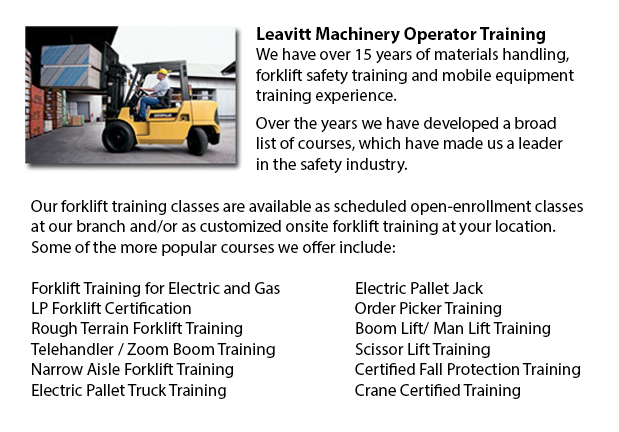
Forklift Training School Goodyear - Why A Forklift Training School Could Actually Help A Business And Its Employees - CSA and OSHA establish criteria for forklift safety training that meets existing regulations and standards. Anyone intending to operate a forklift is needed to successfully complete safety training before utilizing whatever kind of forklift. The accredited Forklift Operator Training Program is meant to provide trainees with the knowledge and practical skills to become an operator of a forklift.
Mobile Equipment and Vehicle safety regulations which apply to forklift operation consist of pre-shift inspections, and regulations for loading and lifting.
An inspection checklist should be carried out and submitted to the supervising authority before beginning a shift. When a maintenance issue is uncovered, the use of the particular equipment should be stopped until the issue has been dealt with. To indicate the equipment is out of service, the keys should be removed from the ignition and a warning tag placed in a location that is visible.
Loading safety regulations comprise checking the forklift nameplate's rating capacity and knowing if the weight of the load falls within capacity. The forklift forks must be in the downward position when the forklift is starting up. Remember that there is a loss of about one hundred pounds carrying capacity for every inch further away from the carriage which the load is carried.
Lifting should start with the driver moving to a stopped position roughly three inches from the load. The mast must then be leveled until it has reached a right angle with the load. Raise the forks to one inch below the slot on the pallet and drive forward. Afterward lift forks four inches. Tilt back the load to secure it for moving. Drive the lift in reverse if the load obscures frontal vision. Check behind and honk in order to alert other personnel. Never allow forks to drag on the ground.
-
Crane / Overhead Crane / Truck Mounted Crane / Hydraulic Cranes Training in Goodyear
Bridge cranes or likewise called overhead cranes are a kind of industrial material handling crane making use of a line and hook device that runs on a horizontal beam running along two widely separated rails. Many overhead cranes can be seen inside a... More -
Fantuzzi Parts
The Italian Fantuzzi Group offers a glut of material handling equipment and heavy machinery. The equipment consists of numerous equipment specializing in transporting, loading and unloading goods. The railway freight sector and the port authority req... More -
Warehouse Forklift Training Classes Goodyear
Warehouse Forklift Training Classes Goodyear - The purpose of warehouse training classes are to raise the awareness of common workplace hazards. The trainees would learn necessary warehouse safety measures. An emphasis is placed on paying attention t... More -
Aerial Lift Ticket Goodyear
Aerial Lift Ticket Goodyear - A boom truck is frequently recognized by the cable and phone business vehicles that have the long arm folded over their roofs. Usually, a bucket-like apparatus sits at the extension of extendable arms. Sometimes termed a... More -
Telehandler Ticket Goodyear
Telehandler Ticket Goodyear - The telescopic handler or telehandler is a generally used equipment in agricultural and industrial applications. This machine is similar in look to a forklift and even works in a similar way, even though telehandlers are... More -
Scissor Lift Safety Training Goodyear
Scissor Lift Safety Training Goodyear - A Scissor Lift is a practical type of platform that normally moves in a vertical direction. The equipment is capable of this movement because of the use of folding supports that are linked in a criss-cross patt... More -
Aerial Boom Lift Training Goodyear
Aerial Boom Lift Training Goodyear - For individuals who operate or supervise the use of aerial lift platforms, right aerial boom lift Training is necessary. The aerial lift platform is for lifting individuals, materials and tools to elevated work lo... More -
Manlift Ticket Goodyear
Manlift Ticket Goodyear - The Elevated Platforms and Manlifts Certification program helps to provide the needed training on the safe operating procedures, work practice, rules and regulations regarding the everyday activities for the operators of thi... More

Forklift Training Goodyear
TOLL FREE: 1-888-254-6157
Goodyear, Arizona
forkliftcertificationgoodyear.com
Email Us
About Us


